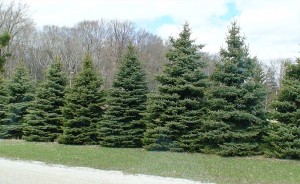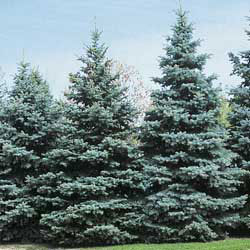Evergreens…Norway or Colorado? One of the great things about landscape architecture is the opportunity to use plant materials to build  environments. Unlike other trades where the finished product will remain much the same in “year twenty-five” as it was at “day one”, the end product continues to change. Plant materials grow, age, and evolve over time, not only in the long term, but in the short term as well. Living in the Midwest, we are fortunate to see how the seasons can dramatically change the landscape. How a particular plant looks in April is not the same as it looks in November. Evergreen plants are often overlooked for what they contribute to a landscape. While people often focus on the changing leaf color of deciduous trees and shrubs, or the bright flowers of perennials and annuals, evergreen plants are invaluable because of their consistency, durability, and permanence.
environments. Unlike other trades where the finished product will remain much the same in “year twenty-five” as it was at “day one”, the end product continues to change. Plant materials grow, age, and evolve over time, not only in the long term, but in the short term as well. Living in the Midwest, we are fortunate to see how the seasons can dramatically change the landscape. How a particular plant looks in April is not the same as it looks in November. Evergreen plants are often overlooked for what they contribute to a landscape. While people often focus on the changing leaf color of deciduous trees and shrubs, or the bright flowers of perennials and annuals, evergreen plants are invaluable because of their consistency, durability, and permanence.
 As you look out the window on a typical fall day you will see the beautiful gold and red colors of the deciduous tree canopy. It’s certainly striking, but sadly short-lived. Over the coming weeks the colors will fade and falling temperatures and strong winds will begin to spread the leaves from the trees to our lawns and gutters. By late November the lawns are frost covered, the fields are harvested, and trees are bare, except for the evergreens. The landscape becomes a woody framework of trees and the humble evergreens, once relegated to the background, are finally given a chance to shine.
As you look out the window on a typical fall day you will see the beautiful gold and red colors of the deciduous tree canopy. It’s certainly striking, but sadly short-lived. Over the coming weeks the colors will fade and falling temperatures and strong winds will begin to spread the leaves from the trees to our lawns and gutters. By late November the lawns are frost covered, the fields are harvested, and trees are bare, except for the evergreens. The landscape becomes a woody framework of trees and the humble evergreens, once relegated to the background, are finally given a chance to shine.
One surprising facet of the late fall and winter landscape is how much more open the landscape feels. A once private patio is suddenly very conspicuous to your neighbors. It’s for this reason that evergreens are so valuable for their ability to visually screen. Where space allows the use of large trees, Norway Spruce and Colorado Spruce will fit the bill. Evergreen trees are also invaluable for providing winter habitat for birds. Utilizing large evergreen trees in conjunction with fall fruiting trees and shrubs will provide food and shelter for birds in your landscape.
Where height is needed and width is limited there are several types of “columnar” evergreens that can work well in groups to create a green wall for visual screening or help to define a space. Similarly, shrubs such as boxwood and yew are perfect candidates for hedging to define spaces. They can be left loose for an informal hedge or tightly sheared for a more formal look. These same plants also work well along the foundation of a house, where they stay low enough to avoid windows, to make great backdrops for flowering perennials.
Additionally, in very visible areas around the landscape, such as near patios, along sidewalks, or near the front door, evergreens make great accent plants. When the perennials have all faded away it’s nice to have living green plants to greet visitors. Interesting selections of spruce, juniper, false cypress, and holly are perfect for this application.
But not all evergreens are large growing or woody stemmed. Evergreen groundcovers such as pachysandra, euonymus, ivy, and low juniper work very well planted below deciduous trees and ensure there is a splash of color in the late fall and winter landscape.
While we often lament the end of fall and the coming of winter, be grateful to live in a climate where we can enjoy the landscape in all of its stages, and be thankful for the evergreen plants and all that they have to offer.
